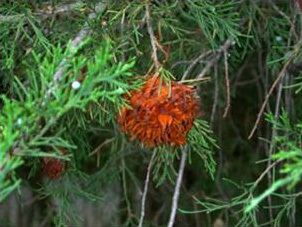Kingdom Fungi Class Urediniomycetes Order Uredinales | Phylum Basidiomycota Subclass Incertae sedis Family Pucciniaceae | |
 | ||
The Telial stage is one of the stages in the life cycle of a parasitic heteroecious fungus. It is discernible by the formation of large teliospores that the fungi produces to overwinter. The telial stage of heteroecious parasitic fungi is spent on the secondary host plant. A primary aecial stage is spent parasitizing a separate host plant which is a precursor in the life cycle of heteroecious fungi. Spores are released from the telia in the spring. The spores can spread many kilometers through the air, however most are spread near the host plant (Brand, 2004).
Contents
Host Plants
There are a number of plants that can be infected by the telial stage. Therefore, the telial stage is considered a pathogen to those plants. A few specific plant pathogenic species are listed here with their hosts.
- Puccinia graminis or known commonly as black stem rust. It infects many different cereal crops.
- Gymnosporangium juniperi-virginianae. It infects the eastern red cedar (Volk, 1999). This is shown to the right.
- Gymnosporangium sabinae. It infects pear trees.
Spore Stages
The life cycle of rust fungi can have up to five different spore stages and can get quite complex (Schumann and D'Arcy, 2010). These stages are:
Works Cited
- Volk, T.J. Tom Volk's Fungus of the Month for May 1999. University of Wisconsin La Crosse. http://botit.botany.wisc.edu/toms_fungi/may99.html, December 5, 2010
- Schumann, G.L. et al. 2010. Essential Plant Pathology. American Phytopathological Society. Second Edition. St. Paul. pp. 43–44
- Brand, A.W. et al. 2004. The Other Half: The telial stage of the rust fungus Gymnosporangium confusum. Field Mycology. Vol 5:14-16
